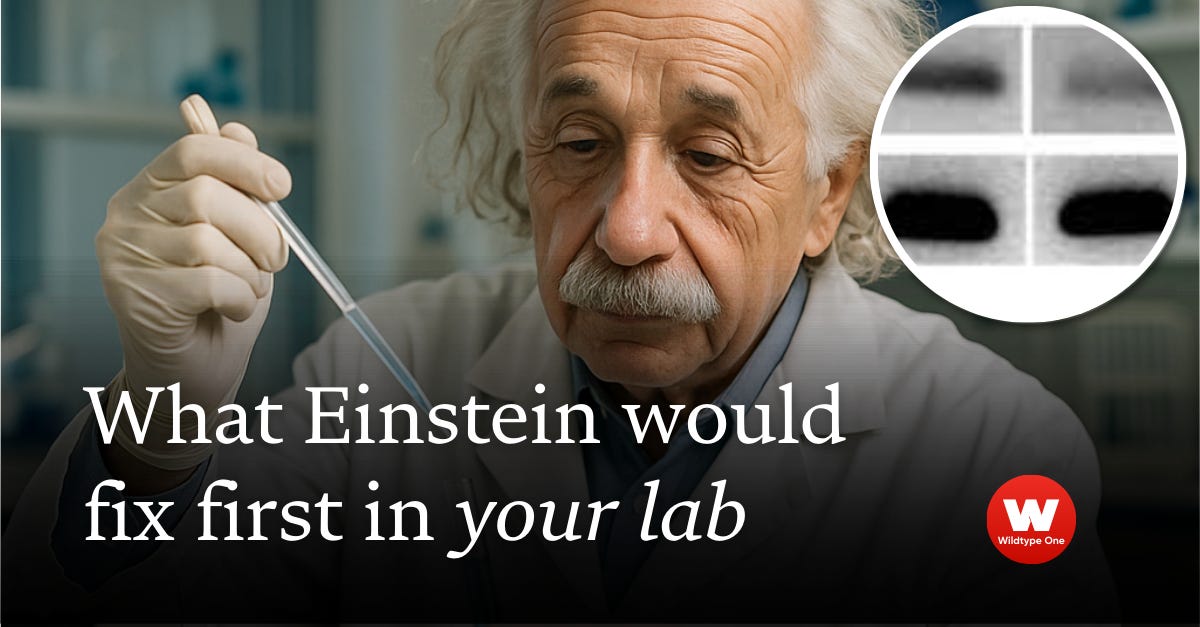If Einstein designed your experiments in 2025…
Here's what Einstein would do in your lab (3 minutes or less).
“If you can’t explain it to a six-year-old, you don’t understand it yourself.”
— Albert Einstein
Dear Elite Researcher,
Einstein was NOT a wizard with his hands. Biographers say he was messy and impatient on the bench.
But put him into a 2025 biology lab? He’d still find a way to bend the rules of the game.
Wildtype One looked into the biography of Albert Einstein to learn from it.
Here’s how the GOAT of science would survive and thrive in a biology lab in 2025 (in 3 minutes or less):
1. Western blots = his worst nightmare
Einstein hated finicky, low-reproducibility work. A smeary WB that worked yesterday but not today? He’d ditch it instantly.
Instead, he’d push multiplexed proteomics and large readouts. He’d be the one asking in lab meeting:
“Why do we accept Western blots failing half the time as normal science?”
Takeaway: Don’t sink weeks into a fragile assay. If there’s a more quantitative, reproducible option—fight for it.
2. Flow cytometry = his playground
Flow gives distributions, not just averages. That’s pure Einstein.
He’d invent new gating strategies, write his own R scripts, and treat “messy” scatter as meaningful data.
While others gripe about day-to-day drift, he’d sketch mathematical corrections for batch effects on the back of a lab napkin.
Takeaway: Noise isn’t just error. Sometimes, the scatter is the story.
3. Microscopy = love and hate
Einstein would obsess over diffraction limits and photon statistics. He’d challenge the whole lab:
“Are those mitochondria swollen—or is that spherical aberration fooling you?”
But cover slips breaking? Mounting medium crystallizing? He’d lose patience fast.
Expect him to migrate toward computational super-resolution and leave the pipetting to others.
Takeaway: Check your optics as carefully as your biology. Artifacts masquerade as discoveries.
4. Chores = automation or bust
Labeling tubes, aliquoting, thawing FBS? He’d be hopeless. Probably the guy who forgets to write dates on cryovials.
But he’d hack around it: lobbying for a liquid handler, bribing the core facility tech, or scripting automation pipelines so he never had to pipette again.
Takeaway: You’re a scientist. Free your head from repetitive chores. Automate, outsource, or systematize where possible.
5. How he’d tackle biology’s messiness
Biology frustrates everyone—variability, irreproducibility, noise. Einstein wouldn’t try to clean it all up. He’d reframe it.
Noise = signal; so he’d mine distributions for invariants
Dogma = suspect; expect him to ask: “Are we sure MAPK is a cascade, or is that just how our assay makes it look?”
Collaboration = survival; he’d partner with a meticulous experimentalist—the modern Besso—to balance his own chaotic style
Einstein at the bench: A vignette
Hair unkempt, lab coat stained. Tubes unlabeled (again). Equations doodled on lab paper towels instead of recorded in the ELN.
Colleagues roll their eyes when he contaminates a gel—but thank him when his reframing of “background scatter” cracks open a new model of immune cell states.
Practical takeaways for you
Channel Einstein without inheriting his mess:
Don’t grind Westerns forever—push toward quantitative, reproducible assays
Look for invariants in noisy data instead of fearing variability
Automate chores to protect your bandwidth
Write your own analysis tools when GUIs hit a wall
Partner with colleagues who complement your weak spots
In short: Einstein would never be the lab’s best pair of hands. But he’d still uncover principles that rewire how we see biology.
As promised, better science in 3 minutes or less.
See you next week,
— Carl from Wildtype One 🧬
PS - Forward this email to a colleague to inspire them.
PPS - Was this email forwarded to you? Use this link to join 400+ elite researchers getting weekly lab hacks and tips (it’s free).


